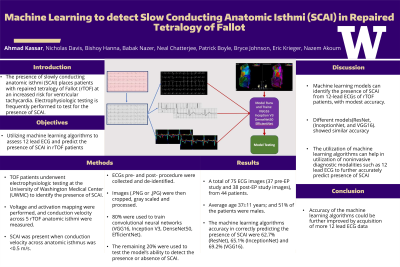Other
Machine Learning to detect Slow Conducting Anatomic Isthmi (SCAI) in Repaired Tetralogy of Fallot

Nicholas Davis, MS – PHD Candidate, Georgia Tech; Bishoy Hanna, MD – Electrophysiology Fellow, University of Washington; Babak Nazer, MD – Cardiac Electrophysiology Attending, University of Washington; Neal Chatterjee, MD – Cardiac Electrophysiology Attending, University of Washington; patrick Boyle, PHD – Assistant Professor, University of Washington; Bryce Johnson, MD – Cardiology Fellow, University of Washington; Eric Krieger, MD – Cardiac Electrophysiology Attending, University of Washington; Nazem Akoum, MD – Section head of Cardiac Electrophysiology, University of Washington
Purpose: The presence of slowly conducting anatomic isthmi (SCAI) places patients with repaired tetralogy of Fallot (rTOF) at an increased risk for ventricular tachycardia. Electrophysiologic testing is frequently performed to test for the presence of SCAI. We hypothesized that machine learning algorithms that utilize 12-lead ECGs can predict the presence of SCAI in rTOF patients.
Material and Methods: TOF patients underwent electrophysiologic testing at the University of Washington Medical Center (UWMC) to identify the presence of SCAI. Voltage and activation mapping were performed, and conduction velocity across 5 rTOF anatomic isthmi were measured. SCAI was present when conduction velocity across anatomic isthmus was < 0.5 m/s. ECGs pre- and post- procedure were collected and de-identified. Images (.PNG or .JPG) were then cropped, gray scaled and processed. 80% were used to train convolutional neural networks (VGG16, Inception V3, DenseNet50, EfficientNet). The remaining 20% were used to test the model’s ability to detect the presence or absence of SCAI.
Results: A total of 75 ECG images (37 pre-EP study and 38 post-EP study images), from 44 patients (average age 3711 years; 51% male) were extracted and included. The machine learning algorithms accuracy in correctly predicting the presence of SCAI were 62.7% (ResNet), 65.1% (InceptionNet) and 69.2% (VGG16).
Conclusions: Machine learning models are capable of identifying the presence of SCAI from 12-lead ECGs of rTOF patients, with modest accuracy. Additional analysis with larger datasets is required for this approach to reliably replace invasive electrophysiologic testing.
Material and Methods: TOF patients underwent electrophysiologic testing at the University of Washington Medical Center (UWMC) to identify the presence of SCAI. Voltage and activation mapping were performed, and conduction velocity across 5 rTOF anatomic isthmi were measured. SCAI was present when conduction velocity across anatomic isthmus was < 0.5 m/s. ECGs pre- and post- procedure were collected and de-identified. Images (.PNG or .JPG) were then cropped, gray scaled and processed. 80% were used to train convolutional neural networks (VGG16, Inception V3, DenseNet50, EfficientNet). The remaining 20% were used to test the model’s ability to detect the presence or absence of SCAI.
Results: A total of 75 ECG images (37 pre-EP study and 38 post-EP study images), from 44 patients (average age 3711 years; 51% male) were extracted and included. The machine learning algorithms accuracy in correctly predicting the presence of SCAI were 62.7% (ResNet), 65.1% (InceptionNet) and 69.2% (VGG16).
Conclusions: Machine learning models are capable of identifying the presence of SCAI from 12-lead ECGs of rTOF patients, with modest accuracy. Additional analysis with larger datasets is required for this approach to reliably replace invasive electrophysiologic testing.
